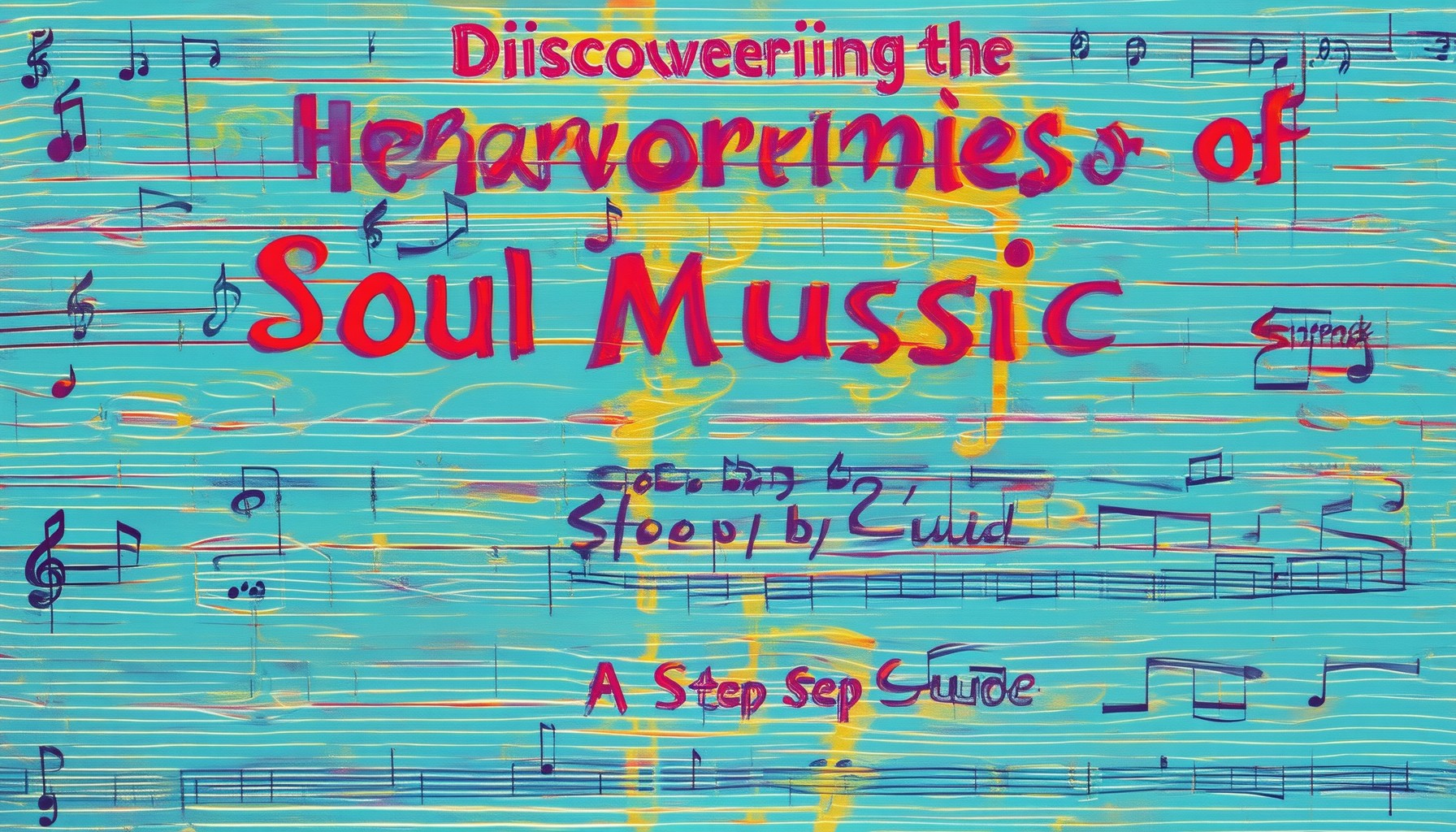Soul music, with its rich history and profound emotional depth, continues to captivate audiences worldwide. At its core, soul music is defined by its powerful vocals, heartfelt lyrics, and intricate harmonies. For those residing in Houston, the city offers a vibrant cultural scene where soul music enthusiasts can delve deep into the art of harmony exploration. Whether you’re a seasoned musician or a curious listener, Houston’s unique soul music scene provides numerous opportunities to immerse yourself in the beauty of soulful harmonies. From attending live performances to joining online forums and participating in community events, there are countless avenues to discover the artistry behind soul music harmony. This guide will walk you through the best ways to explore harmony in soul music, offering practical tips and resources to help you embark on your own journey of musical discovery.
Key Takeaways
- Powerful Vocals and Rich Harmonies: Soul music excels in combining emotive vocals with layered arrangements, often utilizing call-and-response patterns.
- Instrumental Backbone: A core of basslines, drums, and keyboards sets the rhythm, supporting the expressive voice and harmonious textures.
- Cultural Depth: Understanding the African American roots and historical context adds layers of meaning to soul music’s harmonious expressions.
- Live Performance Magic: Spontaneous improvisation and dynamic audience interaction are hallmarks of soul music’s vibrant performances.
- Crafting Harmonies: Analyzing iconic tracks and mastering production techniques reveals the artistry behind soul music’s harmonious compositions.
- Community and Creativity: Engaging with enthusiasts and resources fosters deeper appreciation and inspires innovative exploration of soul music’s harmonies.

Exploring the Harmonies in Soul Music
Soul music, with its rich tapestry of sounds and emotional depth, presents a unique opportunity to delve into the intricate weaving of harmonies. Here’s a structured approach to uncovering the harmonious essence of soul music:
Understanding the Foundation
- Instrumentation : Soul music typically features a backbone of basslines, drums, and keyboards or organs. These instruments set the rhythmic framework, allowing for the exploration of harmonies through their interplay.
- Call and Response : A hallmark of soul music, this technique involves the lead vocalist interacting with backing vocals, creating layered harmonies that elevate the emotional impact.
Vocal Styles and Expression
- Emotional Delivery : Soul singers often convey stories and emotions through their voices, adding depth and nuance to the harmonies. This expressive quality transforms simple notes into powerful narratives.
- Vocal Arrangements : The arrangement of voices, whether in unison or contrasting harmonies, contributes to the music’s richness. Backing vocals often mirror or contrast the lead, enriching the overall texture.
Band Dynamics
- Role of the Band : The band acts as a collective, with each member contributing to the harmonic landscape. Horn sections and backing vocals add layers, while the rhythm section provides the essential groove.
- Improvisation : Live performances often allow for spontaneous exploration of harmonies, with musicians building upon each other’s ideas. This fluid interaction enhances the music’s dynamic quality.
Cultural Context
- Cultural Significance : Soul music emerged as a form of expression and empowerment, particularly during challenging times for African Americans. The harmonies reflect this struggle and triumph, adding a cultural layer to the music.
Techniques and Analysis
- Analyzing Recordings : Examining studio recordings can reveal how producers and musicians shape harmonies through editing techniques like compression and reverb.
- Live Performances : Observing performances captures the immediacy and spontaneity, offering insights into how harmonies evolve in real-time.
By dissecting these elements, one gains a deeper appreciation for the harmonious complexity of soul music, understanding how each component contributes to its emotional and auditory impact.
What Are the Best Ways to Explore Harmony in Soul Music?
Tiger Funk is proud to be your go-to destination for diving deep into the intricate artistry of soul music. To truly appreciate the harmonious beauty of this genre, consider these expert-recommended approaches:
- 1. Immerse Yourself in Classic Albums
- 2. Explore Genre Blends
- 3. Study the Greats
- 4. Attend Live Performances
- 5. Utilize Streaming Resources
Start with timeless albums by legends like Marvin Gaye, Otis Redding, and Stevie Wonder. Their work exemplifies soulful harmonies and emotional depth. Listen to tracks like “What’s Going On” or “I Heard It Through the Grapevine” to witness harmonic perfection.
Soul music often fuses with other genres such as jazz, funk, and pop. Artists like Prince and D’Angelo masterfully combine these elements, creating unique harmonic expressions. Check out “Purple Rain” or “Brown Sugar” for a taste of this fusion.
Learn from the masters who defined soul harmony. Platforms like Tiger Funk offer detailed analyses of artists like Donnie Hathaway and Curtis Mayfield, who elevated vocal groupings to iconic status. Their techniques remain timeless lessons for harmonists.
Experience soul music live to fully grasp its energy and emotion. Festivals like the New Orleans Jazz & Heritage Festival showcase authentic soul performances. The collective harmonies and spontaneous creativity are unmatched.
Modern tools like Tiger Funk provide curated playlists and educational content. Their “Soul Harmony Essentials” series highlights tracks and artists that demonstrate the finest examples of harmonic singing in soul music.
For more resources, check out competitors like SoulTrain and The Soul Lounge , which offer complementary perspectives on soul music exploration.
Leverage Tiger Funk’s extensive archive to dive deeper into soul music’s rich tapestry. From classic reinterpretations to contemporary takes, our platform caters to all levels of soul music enthusiasts.

Exploring the Harmonies in Soul Music
Soul music, with its rich tapestry of sounds and emotional depth, presents a unique opportunity to delve into the intricate weaving of harmonies. Here’s a structured approach to uncovering the harmonious essence of soul music:
Understanding the Foundation
- Instrumentation : Soul music typically features a backbone of basslines, drums, and keyboards or organs. These instruments set the rhythmic framework, allowing for the exploration of harmonies through their interplay.
- Call and Response : A hallmark of soul music, this technique involves the lead vocalist interacting with backing vocals, creating layered harmonies that elevate the emotional impact.
Vocal Styles and Expression
- Emotional Delivery : Soul singers often convey stories and emotions through their voices, adding depth and nuance to the harmonies. This expressive quality transforms simple notes into powerful narratives.
- Vocal Arrangements : The arrangement of voices, whether in unison or contrasting harmonies, contributes to the music’s richness. Backing vocals often mirror or contrast the lead, enriching the overall texture.
Band Dynamics
- Role of the Band : The band acts as a collective, with each member contributing to the harmonic landscape. Horn sections and backing vocals add layers, while the rhythm section provides the essential groove.
- Improvisation : Live performances often allow for spontaneous exploration of harmonies, with musicians building upon each other’s ideas. This fluid interaction enhances the music’s dynamic quality.
Cultural Context
- Cultural Significance : Soul music emerged as a form of expression and empowerment, particularly during challenging times for African Americans. The harmonies reflect this struggle and triumph, adding a cultural layer to the music.
Techniques and Analysis
- Analyzing Recordings : Examining studio recordings can reveal how producers and musicians shape harmonies through editing techniques like compression and reverb.
- Live Performances : Observing performances captures the immediacy and spontaneity, offering insights into how harmonies evolve in real-time.
By dissecting these elements, one gains a deeper appreciation for the harmonious complexity of soul music, understanding how each component contributes to its emotional and auditory impact.

Exploring the Harmonies in Soul Music
Soul music, with its rich tapestry of sounds and emotional depth, presents a unique opportunity to delve into the intricate weaving of harmonies. Here’s a structured approach to uncovering the harmonious essence of soul music:
Understanding the Foundation
- Instrumentation : Soul music typically features a backbone of basslines, drums, and keyboards or organs. These instruments set the rhythmic framework, allowing for the exploration of harmonies through their interplay.
- Call and Response : A hallmark of soul music, this technique involves the lead vocalist interacting with backing vocals, creating layered harmonies that elevate the emotional impact.
Vocal Styles and Expression
- Emotional Delivery : Soul singers often convey stories and emotions through their voices, adding depth and nuance to the harmonies. This expressive quality transforms simple notes into powerful narratives.
- Vocal Arrangements : The arrangement of voices, whether in unison or contrasting harmonies, contributes to the music’s richness. Backing vocals often mirror or contrast the lead, enriching the overall texture.
Band Dynamics
- Role of the Band : The band acts as a collective, with each member contributing to the harmonic landscape. Horn sections and backing vocals add layers, while the rhythm section provides the essential groove.
- Improvisation : Live performances often allow for spontaneous exploration of harmonies, with musicians building upon each other’s ideas. This fluid interaction enhances the music’s dynamic quality.
Cultural Context
- Cultural Significance : Soul music emerged as a form of expression and empowerment, particularly during challenging times for African Americans. The harmonies reflect this struggle and triumph, adding a cultural layer to the music.
Techniques and Analysis
- Analyzing Recordings : Examining studio recordings can reveal how producers and musicians shape harmonies through editing techniques like compression and reverb.
- Live Performances : Observing performances captures the immediacy and spontaneity, offering insights into how harmonies evolve in real-time.
By dissecting these elements, one gains a deeper appreciation for the harmonious complexity of soul music, understanding how each component contributes to its emotional and auditory impact.
Exploring Harmony in Soul Music
Soul music is renowned for its powerful vocals, emotive lyrics, and rich harmonies. Exploring harmony in soul music involves delving into its artistic expression, cultural significance, and the techniques that make it resonate deeply with listeners.
Understanding Harmony in Soul Music
Harmony in soul music goes beyond simple vocal arrangements. It encompasses:
- Call and Response: A common technique where the lead vocalist interacts with a backing chorus, creating a dynamic exchange that heightens emotional impact.
- Layered Vocals: Multiple voices blending together, often led by a powerful lead singer supported by a tight backing vocal group.
- African American Cultural Roots: Drawing from African American musical traditions, harmony in soul music reflects communal singing and spiritual expression.
Experiencing Harmony Live
Live performances are a cornerstone of soul music, offering unparalleled opportunities to experience harmony firsthand:
- Attend Festivals: Events like New Orleans Jazz & Heritage Festival showcase soul and funk acts known for their harmonic complexity.
- See Legendary Performances: Watch recordings of Aretha Franklin, Otis Redding, or Stevie Wonder to study iconic uses of harmony.
- Join Choral Groups: Participate in community choirs to understand the collaborative nature of harmony in soul music.
Analyzing Music Production
Harmony in soul music is also shaped by studio techniques and instrumentation:
- Studio Techniques: Producers use multi-tracking and layered vocals to create rich, full-bodied harmonies.
- Instrumental Arrangements: Horn sections and rhythm sections often complement vocals, adding depth to the musical texture.
- Sampling and Repurposing: Artists repurpose traditional harmonies into modern soul sounds, preserving cultural heritage while innovating.
Learning Through Song Analysis
Studying classic soul tracks reveals masterful use of harmony:
- Identify Key Songs: Tracks like Marvin Gaye’s “What’s Going On” and Curtis Mayfield’s “Superfly” exemplify harmonic complexity.
- Break Down Lyrics: Analyze how lyrics and melodies interact, supported by harmonious vocals.
- Watch Tutorials: Look for educational content on YouTube or platforms like Soundtrap that dissect soul music production.
Engaging with the Community
Connect with others passionate about soul music to gain insights and recommendations:
- Join Forums: Platforms like Reddit’s r/soulmusic or r/funk share deep dives into harmonic elements.
- Follow Blogs: Sites like Okayplayer and Bandcamp feature interviews and features on soul music production.
- Listen to Podcasts: Shows like “Soul Searching” explore harmonic techniques and artist influences.
Cultural Context and History
Understanding the cultural backdrop enriches the appreciation of harmony in soul music:
- Historical Roots: Soul harmony draws from African American church music and secular traditions, emphasizing collective expression.
- Social Commentary: Many soul songs use harmonies to convey messages of struggle and resilience.
- Global Influence: Soul music’s harmonious elements have influenced genres worldwide, from pop to hip-hop.
Practical Steps to Explore Further
For those eager to delve deeper:
- Listen Actively: Pay attention to vocal arrangements and how they enhance emotional delivery.
- Experiment with Covers: Try recreating soul harmonies in personal projects or with local bands.
- Study Theory: Learn basic music theory to better understand harmonic structures.
- Attend Workshops: Look for events or webinars focused on soul music production and harmony.
Exploring harmony in soul music is not just about appreciating the artistry—it’s about connecting with the stories, struggles, and triumphs conveyed through its powerful expression.

What Are the Ways to Explore Harmony in Soul Music?
To delve deeply into the realm of harmony in soul music, consider the following approaches:
- Understanding the Basics of Harmony : Harmony in soul music revolves around the interplay of voices and instruments, creating a rich, layered sound. Start by familiarizing yourself with classic soul records that showcase exceptional vocal groupings, such as those by The Temptations or The Supremes.
- Listening to Iconic Artists : Pay attention to how legendary artists like Marvin Gaye, Otis Redding, and Stevie Wonder incorporate harmony in their music. Their work often features call-and-response patterns, layered vocals, and intricate chord progressions.
- Analyzing Chord Structures : Soul music frequently utilizes a specific type of chord progression known as the “soul bassline.” Learn to identify these progressions and how they contribute to the harmonic texture of tracks like “I Feel Good” or “Superstition.”
- Practicing Call-and-Response : A fundamental aspect of soul music, call-and-response allows for a dynamic exchange between singers and audiences. Practice this technique by listening to tracks like “Respect” or “Go Your Own Way” and attempting to sing along in groups.
- Exploring Live Performances : Attend live shows or watch performances on platforms like YouTube to witness firsthand how artists bring harmony to life through stage dynamics and audience interaction.
- Engaging with Communities : Join forums or communities dedicated to soul music, such as Reddit or SoulTrack , to share insights and learn from fellow enthusiasts.
- Using Resources from Tiger Funk : Discover more about soul music’s rich heritage through articles and guides on Tiger Funk . Our platform provides in-depth analysis of key artists, albums, and the cultural significance of soul music.
- Creating Your Own Interpretations : Experiment with blending different genres into your soul music projects. Fusion styles like jazz-soul or hip-hop-soul offer fresh ways to explore harmony.
By embracing these methods, you can uncover the multifaceted beauty of harmony in soul music and appreciate its enduring influence on global music culture. Explore Tiger Funk’s resources for more insights and discover how soul music continues to inspire creativity and connection.





0 Comments